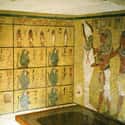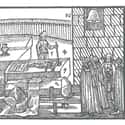-
(#7) Slaves And Family Members Were Sacrificially Immured
The burial of a great Mongol Khan included the ritual killings of more than 100 members of his family, followed by his interment and the immurement of several favorite slaves.
He kindly remembered to request that the enslaved people be buried with several vessels of drink.
-
(#1) Immurement Did Not Necessarily Mean Death - Unless They Forgot About Leaving You There
Many cases involving immurement were doled out to intentionally serve as very slow death penalties. However, immurement could also be a temporary condition which was used in one of two ways: as a form of punishment or by choice for a given length of time. The medieval Christian church used temporary immurement as a method to punish sinners, particularly those who committed sins of the flesh. Such individuals were locked away deep in a monastery or bricked up inside of rooms with a tiny opening for food and water for months or even years.
Centuries later, this type of immurement was still being used, but as a form of punishment. A good example comes from the unfortunate end of James Hepburn, third husband of Mary, Queen of Scots, who was accused of treason. After fleeing Scotland, he was apprehended in Denmark where he was imprisoned beneath Dragsholm Castle. He was put in a hole that was not large enough for him to stand in and subsisted off of food scraps in total darkness.
Danish authorities more or less forgot about Hepburn, and he remained in his hole for five years. When he was finally found, he acted like a feral animal. Hepburn did not use language, but instead only grunted and paced back and forth. He died shortly after.
Some cases of immurement had willing participants. Christian monks and nuns participated in immurement as a spiritual experience. They would choose the method, location, and length of time involved.
-

(#5) Bodies Trapped In A Wall For Entertainment Purposes
Jazzar Pasha was a notorious 18th-century governor of Lebanon and Palestine. He was known for committing unspeakable cruelties to anyone who angered him.
At some point during his rule, he decided to build a new wall around the city of Beirut. And not just any wall - he wanted a structure that was strong, decorative, and entertaining. To that end, he captured a great many Greek Christians and had them essentially built into the wall.
-

(#8) People Were Immured Into Building Foundations As A Good Luck Charm
When you've created something you're proud of, you want to make sure it has the good luck to last forever. Such was the thinking of those who immured people - including children - in the foundations of a building. Especially under the cornerstone. It was a good luck charm sort of thing.
There was a Serbian tradition where a building project may not progress until the wife of one of the owners of the new building was immured into the foundation. The Magyars tell a similar tale of the building of the city of Deva, in which the compassion of the landowning spirit was derived by sacrificing the wife of one of the men who built the structure.
-
(#4) Clerics Who Molested Boys Were Starved To Death In A Suspended Coffin
In 1409, four Christian clerics in Augsburg, Bavaria, were found guilty of pederasty, or sexual conduct with young boys. Pederasty was not only considered immoral but also illegal.
The church in Augsburg locked the guilty men into wooden coffins, suspended them with ropes from high inside a tower, and left them to starve. They were then buried under the gallows.
-
(#6) King Richard II Of England Was Bricked Up
King Richard II of England ruled during the age in which Geoffrey Chaucer wrote his famous Canterbury Tales. It was a time of chivalry and Richard's court was considered one of beauty and fashion. He was so interested in beauty, art, and culture that he lost track of political situations in his country.
Richard was deposed by a powerful rival. Having lost his crown, he was sent off to a castle where he presumably starved to death. Apparently, his murderers felt immurement was the best method to rid themselves of the former king since starvation would not show any marks or damage to the body.
New Random Displays Display All By Ranking
About This Tool
Burial alive is a commonly used punishment in wars and is generally used for mass killings. There is no doubt that being buried alive or bricked up is one of the most painful and terrifying disasters so far. The suffering is that it allows the victim to clearly feel the process of the death, asphyxiation and hypoxia are more painful than other punishments. Those who have deep thoughts about history will never deny that these cruel
punishments have occurred frequently in human history.
History is full of terrible stories of people being bricked up or buried alive, and even some religious ceremonies or ancient customs regard these ways as sacred. The random tool shares 11 stories of people who bricked up or buried alive in history.
Our data comes from Ranker, If you want to participate in the ranking of items displayed on this page, please click here.














